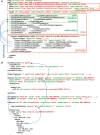SBML Level 3: an extensible format for the exchange and reuse of biological models
- PMID: 32845085
- PMCID: PMC8411907
- DOI: 10.15252/msb.20199110
SBML Level 3: an extensible format for the exchange and reuse of biological models
Abstract
Systems biology has experienced dramatic growth in the number, size, and complexity of computational models. To reproduce simulation results and reuse models, researchers must exchange unambiguous model descriptions. We review the latest edition of the Systems Biology Markup Language (SBML), a format designed for this purpose. A community of modelers and software authors developed SBML Level 3 over the past decade. Its modular form consists of a core suited to representing reaction-based models and packages that extend the core with features suited to other model types including constraint-based models, reaction-diffusion models, logical network models, and rule-based models. The format leverages two decades of SBML and a rich software ecosystem that transformed how systems biologists build and interact with models. More recently, the rise of multiscale models of whole cells and organs, and new data sources such as single-cell measurements and live imaging, has precipitated new ways of integrating data with models. We provide our perspectives on the challenges presented by these developments and how SBML Level 3 provides the foundation needed to support this evolution.
Keywords: computational modeling; file format; interoperability; reproducibility; systems biology.
© 2020 California Institute of Technology Published under the terms of the CC BY 4.0 license.
Conflict of interest statement
TH has served as a shareholder and/or has consulted for Discovery Collective, Inc.
Figures


References
Publication types
MeSH terms
Grants and funding
- R01 GM070923/GM/NIGMS NIH HHS/United States
- P41 EB023912/EB/NIBIB NIH HHS/United States
- P41 GM103504/GM/NIGMS NIH HHS/United States
- BB/M017702/1/BB_/Biotechnology and Biological Sciences Research Council/United Kingdom
- R01 GM080219/GM/NIGMS NIH HHS/United States
- R01 GM057089/GM/NIGMS NIH HHS/United States
- P41 GM103313/GM/NIGMS NIH HHS/United States
- R35 GM119770/GM/NIGMS NIH HHS/United States
- U24 EB028887/EB/NIBIB NIH HHS/United States
- 26815/CRUK_/Cancer Research UK/United Kingdom
- R01 GM111510/GM/NIGMS NIH HHS/United States
- R01 GM095485/GM/NIGMS NIH HHS/United States
- R35 GM119771/GM/NIGMS NIH HHS/United States
- R01 GM075742/GM/NIGMS NIH HHS/United States
- U19 AI117873/AI/NIAID NIH HHS/United States
- P41 GM103712/GM/NIGMS NIH HHS/United States
- R01 GM123032/GM/NIGMS NIH HHS/United States
- BB/N019482/1/BB_/Biotechnology and Biological Sciences Research Council/United Kingdom
LinkOut - more resources
Full Text Sources
Other Literature Sources
Miscellaneous

